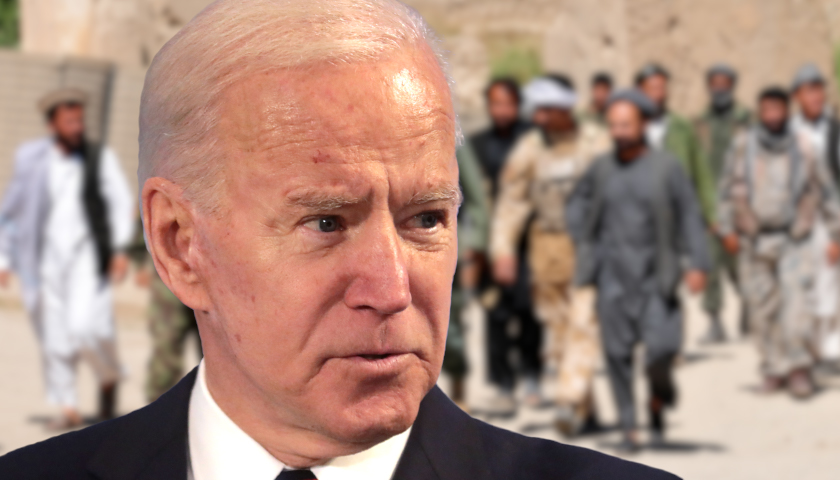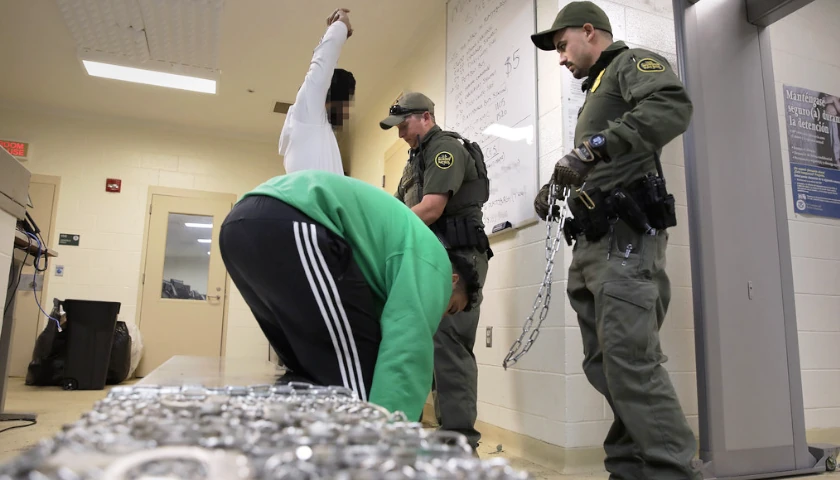by Robert Romano
“Our military mission in Afghanistan will conclude on August 31st. The drawdown is proceeding in a secure and orderly way, prioritizing the safety of our troops as they depart… And thanks to the way in which we have managed our withdrawal, no one — no one U.S. forces or any forces have — have been lost. Conducting our drawdown differently would have certainly come with a increased risk of safety to our personnel.”
That was President Joe Biden as recently as July 8 justifying not just a drawdown, but a rapid drawdown of U.S. military presence in Afghanistan, trying to reach an arbitrary goal of zero troops in the country by the end of this month.
At the time, Biden explained, “Our military commanders advised me that once I made the decision to end the war, we needed to move swiftly to conduct the main elements of the drawdown. And in this context, speed is safety.”
Now, more than a month later, because that turned out not to be true, instead of decreasing, Biden is increasing the amount of U.S. military to 5,000 troops in Afghanistan in order to secure Kabul airport so that the evacuation of U.S. personnel and fleeing Afghans can continue.
So far, 1,500 Americans have been evacuated, but there are 11,000 Americans who are stranded in Afghanistan as of this writing which is now under Taliban control, with thousands more Afghans begging to leave.
According to the Department of Defense, as of Aug. 16: “About 2,500 U.S. troops have moved into Kabul within the last 72 hours, and more will arrive soon, the general said, adding that at the end of the day, nearly 3,000 to 3,500 troops are expected on the ground.”
And as of Aug. 17: “the airport is under U.S. control, and there are about 4,000 U.S. troops on the ground in Kabul.”
But why weren’t these troops already pre-positioned to assist with what has become a chaotic withdrawal that saw the government of Afghanistan collapse overnight amid a months-long Taliban offensive? Why was a rapid drawdown preferred?
Moreover, why weren’t the civilians evacuated first during the drawdown?
Politics. That is, Biden had a political goal to reach from the very beginning of his plans to withdraw the military from Afghanistan — in time for the 20th anniversary of the attacks of Sept. 11, 2011 on the Pentagon and World Trade Center — with little consideration given for the aftermath if the government happened to rapidly fall.
As reported by the New York Times’ Helene Cooper, Eric Schmitt and David E. Sanger on April 17, “President Biden used his daily national security briefing on the morning of April 6 to deliver the news that his senior military leaders suspected was coming. He wanted all American troops out of Afghanistan by Sept. 11, the 20th anniversary of the attacks on New York and the Pentagon.”
The piece, entitled, “Debating Exit From Afghanistan, Biden Rejected Generals’ Views” outlines warnings issued from Defense Secretary Lloyd Austin and Chairman of the Joint Chiefs of Staff Gen. Mark Milley that a precipitous withdrawal with no strings attached could result in the Taliban rapidly taking back control of Afghanistan.
According to the Times: “The current military leadership hoped it, too, could convince a new president to maintain at least a modest troop presence, trying to talk Mr. Biden into keeping a residual force and setting conditions on any withdrawal. But Mr. Biden refused to be persuaded… There would be no conditions put on the withdrawal, Mr. Biden told the men, cutting off the last thread — one that had worked with Mr. Trump — and that Mr. Austin and General Milley hoped could stave off a full drawdown. They were told, Zero meant zero.”
So, to meet Biden’s arbitrary deadline of having troops withdrawn on the 9/11 anniversary, the government of Afghanistan has immediately collapsed far sooner than almost anyone anticipated.
Again, as recently as July 8, Biden was saying all was well: “The drawdown is proceeding in a secure and orderly way…”
But by that time, Biden — and the Pentagon for that matter — had to have been well aware of the Taliban’s offensive that was launched in the spring as a direct result of Biden’s April 14 announcement that “I have concluded that it’s time to end America’s longest war. It’s time for American troops to come home… The plan has long been “in together, out together.” U.S. troops, as well as forces deployed by our NATO Allies and operational partners, will be out of Afghanistan before we mark the 20th anniversary of that heinous attack on September 11th.”
The Taliban’s offensive was launched at the beginning of May. By the end of June, the situation on the ground had rapidly deteriorated in favor of the Taliban.
As reported by Bill Roggio of the Long War Journal, as of June 29: “The Taliban has taken control of more than 80 districts in the two months since launching its offensive against the Afghan government after President Joe Biden announced the U.S. would withdraw its forces from the country by September. In many cases, Afghan security forces have turned over district centers, abandoned military bases, surrendered to the Taliban and handed over their weapons, vehicles and other war material without a fight. The Taliban’s multi-year strategy of gaining influence in rural districts to then pressure the population centers is paying dividends. Prior to the Taliban offensive, which began in earnest on May 1, the date that the U.S. government originally committed to completing its withdraw under the Doha agreement, the Taliban controlled 73 of Afghanistan’s 407 districts, and contested 210, according to an ongoing assessment by FDD’s Long War Journal. The Biden administration moved the withdraw date to Sept. 11, 2021, the 20-year anniversary of Al Qaeda’s attack on American soil – which it plotted and executed largely from Afghanistan. The Taliban began to seize territory once the May 1 deadline expired, and as of June 29, 2021, now controls 157 districts.”
That is all public information. And so, it certainly would have been a topic of interest to Presidential Daily Briefing, which at this stage should be declassified so the American people can pinpoint with footnote accuracy every single one of the lies that Biden had been telling the past several months about the drawdown of U.S. troops.
In July, the drawdown was “proceeding in a secure and orderly way,” but the direct result had already turned over half of Afghanistan back to the Taliban in rapid succession.
The military’s public proclamations weren’t much better than Biden’s. On July 21, Defense Secretary Austin told reporters, falsely, that all was well: “Our drawdown continues in a safe and orderly manner, and we’re still on track to finish up by the end of August. The president has made a decision that we’re going to get it done, and we’re going to get it done right, and we have four ongoing key tasks. We remain committed to protecting our diplomatic presence in Afghanistan and to providing funding to the Afghan National Defense and Security Forces, and to advising Afghan security ministries, and to preventing the — the reemergence of transnational terrorist organizations. And we’ve added a fifth urgent task, and that is working closely and urgently in support of the State Department as they relocate brave Afghans and their families who have provided such exceptional service during our long mission.”
And Gen. Milley stated that the Afghan Security Forces — even as they were surrendering territory at a record pace — were definitely up to the task of defending Afghanistan: “The Afghan Security Forces have the capacity to sufficiently fight and defend their country, and we will continue to support the Afghan Security Forces where necessary in accordance with the guidance from the president and the secretary of defense… I’ve said this before, a negative outcome, a Taliban automatic military takeover, is not a forgone conclusion.”
Nothing but happy talk. Not a whiff about the Taliban’s ongoing offensive. By then, the Pentagon is simply toeing the Biden company line: The military drawdown was proceeding apace, and Afghanistan was well in the hands of Afghan security forces.
It was a lie.
By July 21, Roggio at Long War Journal reports the situation in Afghanistan wasn’t much better than when Biden had spoke on July 8. As Roggio noted on July 12, “The Taliban and its allies have taken control of 139 districts in the span of less than two months, nearly tripling the territory under its rule. Multiple provincial capitals are now under direct Taliban threat, and it has launched incursions in cities such as Ghazni, Kunduz, Kandahar, Lashkar Gah, Maidan Shahr, Mihtarlam, Taloqan, Sheberghan, and Qala-i-Naw. Afghan security forces, meanwhile, have largely been on the defensive and have only managed to regain control of a handful of districts.”
So much for that.
Now, on Aug. 16, Biden in addressing the nation admitted his team had no idea Afghanistan would fall so quickly: “The truth is: This did unfold more quickly than we had anticipated.”
Whoops. Meaning, not only did Biden not listen to the generals. The generals didn’t listen to the generals. They weren’t ready for a very predictable outcome.
All to meet an arbitrary, political deadline of ending the war in Afghanistan before the sun rose on the 20th anniversary of the attacks of Sept. 11. Biden was planning a celebration ending the war — in national disgrace, as it turns out — that simply could not be postponed.
And now, the U.S. is depending on the Taliban to allow Americans to leave Kabul. National security adviser Jake Sullivan told reporters on Aug. 17, “The Taliban have informed us that they are prepared to provide the safe passage of civilians to the airport, and we intend to hold them to that commitment,” and that the administration is “in contact with the Taliban to ensure the safe passage of people to the airport.”
Nobody comes out of this looking good. Not Biden. Not the Defense Secretary Lloyd. Not the Joint Chiefs. Not the Pentagon.
And not America. This is a national disgrace. No man left behind?
God protect those still stranded in Afghanistan, and speed their returns home. If they are allowed to leave, it will be because of the mercy of the Taliban. They should have been the ones to leave first, with the military to follow.
– – –
Robert Romano is the Vice President of Public Policy at Americans for Limited Government.
Background photo “Taliban Insurgents” by Geo Swan (CC BY 2.0), photo “Joe Biden” by Gage Skidmore (CC BY-SA 2.0).




